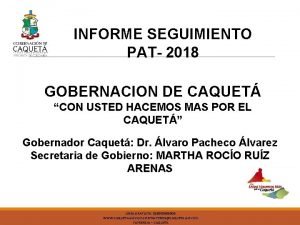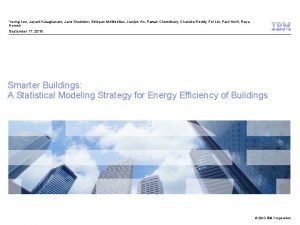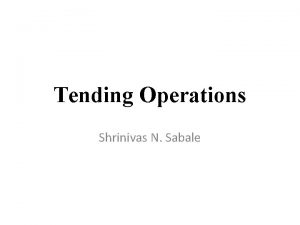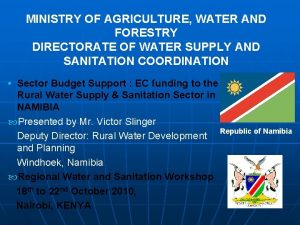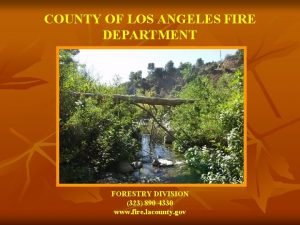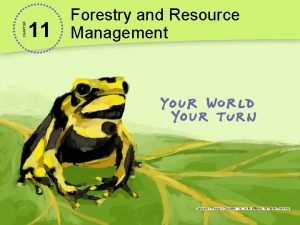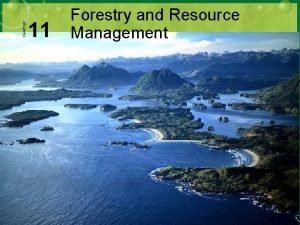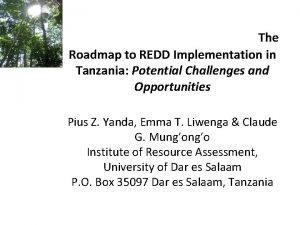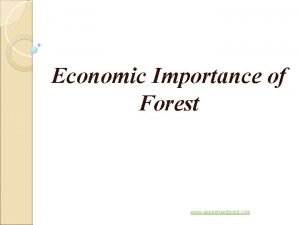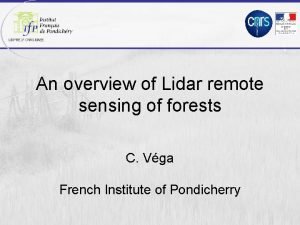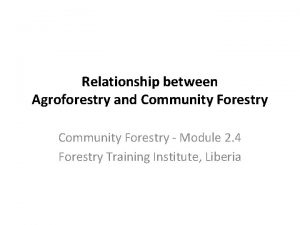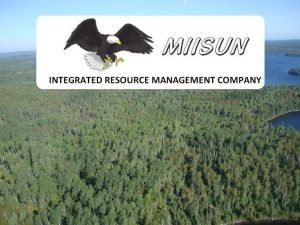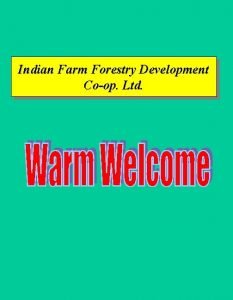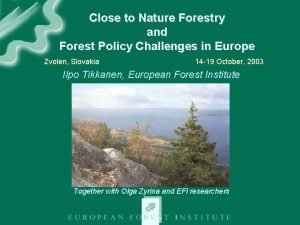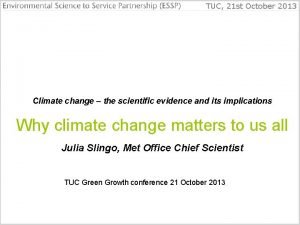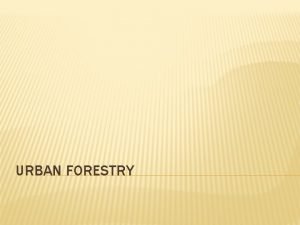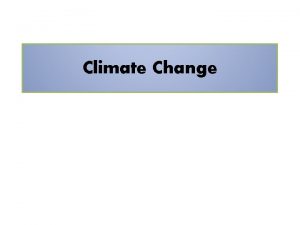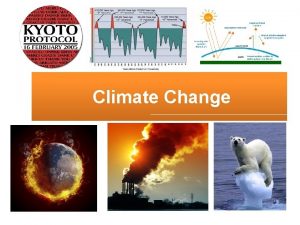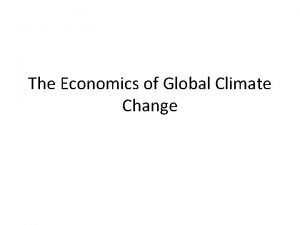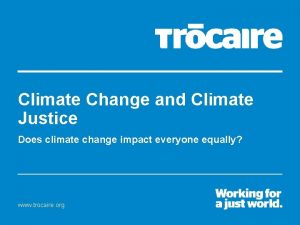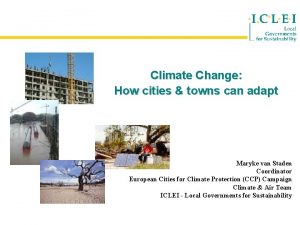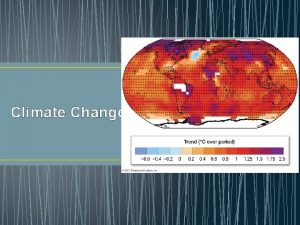Dr Pat Snowdon Economics Climate Change UK Forestry


































- Slides: 34

Dr Pat Snowdon Economics & Climate Change, UK Forestry Commission Presentation to European Forestry Commission, 27 April 2010

This presentation… • Aim explain how the Forestry Commission in the UK commissioned an assessment of the role of UK forests in tackling climate change • Structure the process key findings

Why do this? • IPCC 4 th Assessment Report, 2007 – brought together existing science & understanding “forestry can make a very significant contribution to a low-cost global mitigation portfolio…” We needed a similarly authoritative statement of current scientific understanding across the UK

How can UK forestry adapt to and improve its contribution to mitigating climate change? Sir David Read was asked to: • Review and synthesise existing knowledge of the impacts of climate change on UK forests. • Provide a baseline of the potential of UK forests to mitigate and adapt to climate change. • Identify gaps and weaknesses in our understanding so as to determine research priorities for the next 5 years.

The process Summer 2008 • • • facilitated by the FC independent steering group established authors invited (c 30 in total) reviewed by international experts editorial group publication and launch November 2009

The authors • Editor and Chair – Professor Sir David Read, University of Sheffield & Fellow of the Royal Society • Experts from universities, research institutes and Government departments and agencies • Multi-disciplinary approach

Finalising the report • Editorial group meetings • Consultation with authors over editing • Independent of the Forestry Commission - Sir David had editorial control • Focus on scientific rigour

Report structure

Who will use it & for what?

UK will continue to warm in all scenarios

But we’ve been creating fewer new woodlands

Can we harness this C-fixing capability to provide mitigation of emissions?

Oak – suitability relative to maximum productivity (greens = suitable) Changes will impact on species choice and composition in native woodlands

Substitution – carbon lock up after felling Biomass – replacing fossil fuels Different objectives and strategies : all +ve

Wood products extend carbon lock up Wood products in construction are CO 2 sinks. Bricks, concrete, steel are net sources.

Maximum surface temperature in Manchester +10% green cover would help cooling esp where people live or gather

Key findings

Carbon in UK woodlands (trees only)

A clear need for more woodlands Enhanced planting of 23, 000 ha per year over next 40 years could by 2050 abate 10% of GHG emissions • Technically feasible – if challenging • All options cost-effective • Rapid growing conifers and energy crops best • But mixed woodlands still only £ 25 per tonne CO 2

Forest land cover in parts of Europe +4% change in land cover proposed would still be one of lowest in Europe

An asset to be managed wisely UK forests store 790 Mt. C and remove 15 Mt. CO 2 per year • Climate change impacts are already being seen • Pests and diseases causing increasing concern • Regulatory framework important including for urban trees to ensure continued delivery of range of ecosystem services

The status quo is not an option Long timescales mean need for action now • Changes to selection of species and origin needed now • In future need to consider new species e. g. from continental Europe • Difficult questions for conservation of biodiversity in woodland communities

Harvesting and use of wood increases forestry’s mitigation potential Wood products act as store Biomass can replace fossil fuels • Wood can substitute for materials with high GHG emissions in their production • Evidence of technical properties of wood needs to be better known • Carbon in wood products in UK housing = 19 Mt. C – could grow by 10 Mt in next 10 years

Trees help people adapt Trees in urban areas provide shelter shade and runoff control • increased tree cover in towns where people live and gather, esp vulnerable groups • forestry practitioners need to engage with the public • policy incentives should reward non-market benefits of forests

Plant now Use sustainably

What next?

response to the Assessment • • research priorities ongoing analysis standards incentives – GHG reporting guidelines – funding mechanisms

Tell people!

Thank you www. forestry. gov. uk/climatechange www. tsoshop. co. uk

Net ecosystem carbon exchange Trees and forest soils lock up carbon

Impacts on abatement potential compared to BAU

Rainfall amounts and distribution will change

Oak is coming into leaf earlier

Uptake of greenhouse gases is projected to fall
 Climate change 2014 mitigation of climate change
Climate change 2014 mitigation of climate change Pat pat seguimiento
Pat pat seguimiento Anne snowdon
Anne snowdon Peter snowdon shell
Peter snowdon shell Jane snowdon
Jane snowdon Snowdon neurological rehabilitation unit
Snowdon neurological rehabilitation unit Objectives of thinning
Objectives of thinning Ministry of agriculture, water and forestry directorates
Ministry of agriculture, water and forestry directorates Forestry licence viewer
Forestry licence viewer La county fuel modification
La county fuel modification Chapter 11 forestry and resource management
Chapter 11 forestry and resource management Battling over clayoquot big trees
Battling over clayoquot big trees Forestry io roadmap
Forestry io roadmap Careers related to forestry
Careers related to forestry Mendel university fees
Mendel university fees Economic importance of forest
Economic importance of forest Lidar remote sensing for forestry
Lidar remote sensing for forestry State and private forestry
State and private forestry Difference between agroforestry and community forestry
Difference between agroforestry and community forestry Miisun forestry
Miisun forestry Maine dept of agriculture
Maine dept of agriculture Coop
Coop Forestry tep
Forestry tep Eturgu
Eturgu State forestry administration
State forestry administration Close-to-nature forestry
Close-to-nature forestry School of business and economics maastricht
School of business and economics maastricht Mathematical vs non mathematical economics
Mathematical vs non mathematical economics Climate change paragraph
Climate change paragraph Karnataka state action plan on climate change
Karnataka state action plan on climate change Brainpop climate types
Brainpop climate types Climate change meaning
Climate change meaning Atmosphere
Atmosphere Unit 9 climate change
Unit 9 climate change Conclusion of climate change
Conclusion of climate change

